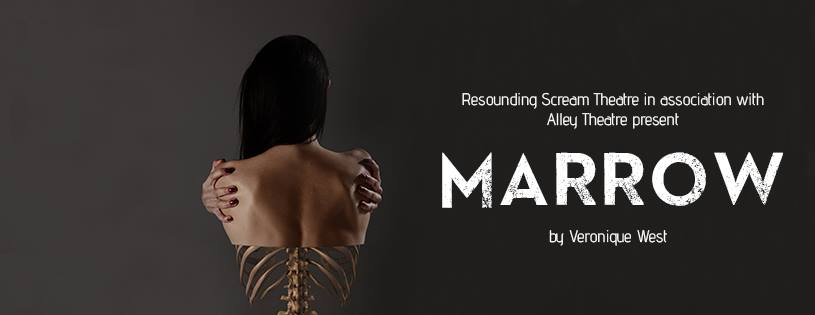Woman to Woman, Sister to Sister
A review of Marrow at the Vancouver Fringe Festival
The Havana Theatre has changed since I was last here. I’ve seen a few performances at this venue before; I remembered entering through the restaurant into a dark, spacious room where chairs were set out for audience members. Now, we are guided through a separate entrance; and once inside, I’m impressed to see long rows of tiered audience seating. I sit front and centre, and take in the scene before me.
Lights sit on the floor at each end of the stage, emitting a softly pulsing orange glow; in their square black fixtures, they remind me of lanterns, their flames growing and diminishing in passing draughts of air. Seated in each of the stage’s farthest corners, beyond these lights, is a young woman: dark hair, dark eyes, clad all in black. The two women stare across at each other; the one on the left looks determined and confrontational, the one on the right pensive and sad.
At centre stage sits a symmetrical arrangement reminiscent of a Dutch still-life: a black wine bottle stands before a flat-lying book hardbound in a sienna brown cover; atop of the book are two glasses, and behind it lies a slice of white bread. In the nearly sepia-toned ambiance, the arrangement looks less like a still life and more like a vanitas. The addition of a skull would make it a memento mori par excellence. We wait. A stagehand brings more objects: four mason jars, containing lit wax candles, are placed on the stage – two next to the book, and one near each of the black-clad women. Marrow begins.
Marrow follows two sisters: Maura, a recovering bulimic, played by Baraka Rahmani; and Morgan, a graduate student and witchcraft historian played by Alexandra Lainfiesta. In the given circumstances, Maura is at odds with her and Morgan’s mother, and comes to seek refuge at Morgan’s flat. It’s here that she pries into her elder sister’s research, even getting hold of the Malleus Maleficarum – the legendary witch hunter’s handbook. As the young women learn more about each other, they struggle to settle their differences – Maura’s fight with her illness and Morgan’s meteoric success in academia – only to realise that they may not be so different after all. They both see an implicit connection between Maura’s bulimia and Morgan’s research.
The trouble is that each woman draws very different parallels.
To start, we have to understand Morgan’s thesis. Morgan believes that victims of the medieval witch-hunts confessed to witchcraft not because they were under duress, but to assert their autonomy. By participating in rituals, or by affirming that they were witches, these women liberated themselves from the religious patriarchy that belittled them. The issues with Morgan’s claims are myriad, but it’s not my place to debate them here. Suffice to say that she sees Maura’s recovery as an analogue to medieval witches’ self-determination: by staying in a facility, consulting with a psychiatrist, finding a healthy outlet in kickboxing and managing her weight, Maura is combating societal expectations of beauty, body image, and female weakness.
For Maura, however, her eating disorder was never about misogyny or self-destruction. It was a release from the pressures of her family; she defied her mother’s lofty expectations by running in the opposite direction. Through bulimia, Maura felt in control of at least one aspect of her life, even when she thought of herself as powerless and inadequate, living in Morgan’s shadow. She’s shocked to discover that Morgan likens the accused witches to recovering bulimics. In Maura’s mind, the women’s admission of guilt was a release, an escape, a last-ditch attempt to have some say in their own fates: confessing to witchcraft was no different than binging and purging.
The script, by playwright Veronique West, is intricate and ambitious, weaving between trancelike soliloquies that describe a witch’s black magic; monologues in which Maura argues with her therapist or Morgan defends her thesis; and – most prominently – the sisters’ banter in their apartment. Ada-Jane Elrick’s cinematic lighting queues evoke these various spaces; candles illuminate the darkened set during the witchcraft sequences, as the women draw chalk pentagrams on the floor; a simple, stark spotlight is all that is needed to convey a psychiatrist’s clinic, or a roomful of Morgan’s stony-faced adjudicators. At times, the script might be too ambitious, to the point where the play’s core themes feel crisscrossed and convoluted, and I find myself questioning my own understanding of them.
Perhaps my confusion stems from the fact that I’ve anticipated a more overt critique of male chauvinism. With themes like witchcraft and bulimia, there’s an automatic assumption that men’s transcultural subjugation, objectification, and fear of women will be called into question. Let’s look at the word ‘witch’, for a moment. It’s one of those many insults against females, such as ‘crone’ or ‘hag’, that have no male equivalents. When a woman is called a witch, it implies that she’s nasty and conniving; it’s also meant to make her feel unattractive. But when we call a man a ‘wizard’, it means he’s a genius. And if you call a man a ‘warlock’, you’re probably LARPing.
Think of the many fairy tales featuring witches, or wicked queens, or jealous stepmothers. Powerful, confident women who lived independently were so despised by the fabulists that they cast such characters as impulsive and bloodthirsty villains, whereas the submissive, virginal, husband-needing girls were hailed as canonical protagonists. And what of male villains? Where are the murderers, abusers, and despots we see on the nightly news? The male authors inflicted those roles on animals – wolves in particular – or else had the poor, hapless husband under his wife’s iron-heeled control, or the king who was only evil because a witch had cursed him.
But Marrow doesn’t venture there. One of the reasons it shines as a feminist play is that men simply don’t factor in any major way. Their gynophobia can be traced in the background – as it can in just about any situation – but by and large, these women operate in a totally different sphere: woman to woman, sister to sister. And for all its complexity, the play is gripping right through, thanks to the poetic, deftly-measured pacing of director Marisa Emma Smith.
And the actresses who carry Marrow’s difficult dialogue are sensational. The relationship between Maura and Morgan, and their development as individuals, is the highlight of the performance. We watch as Maura evolves from being rash and insecure to outspoken and courageous; Morgan is introduced as something of a haughty know-it-all, who crumbles into a bewildered wreck as her graduate research – her most treasured truths – come under fire. There are moments of family love and rocky history that sparkle; the nuanced, emotional journeys that both Lainfiesta and Rahmani bring to their characters are honest and natural.
With a daring concept, intelligent writing, and a superb cast and crew, Marrow is a standout in this year’s Fringe Festival. Theatregoers should be eager to see what playwright Veronique West devises next.
Review written by Justin Ramsey.

Justin Ramsey holds a Masters in Comparative Media Arts from Simon Fraser University. He works as an arts administrator with various institutions including Presentation House Gallery, North Vancouver, and Republic Gallery, Vancouver. As a freelance writer, Justin has contributed to several publications and platforms, including MONTECRISTO Magazine and NUVO Magazine.


